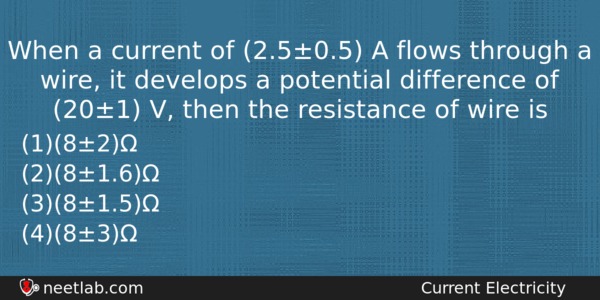| ⇦ | 
| ⇨ |
When a current of (2.5±0.5) A flows through a wire, it develops a potential difference of (20±1) V, then the resistance of wire is
Options
(a) (8±2)Ω
(b) (8±1.6)Ω
(c) (8±1.5)Ω
(d) (8±3)Ω
Correct Answer:
(8±2)Ω
Explanation:
No explanation available. Be the first to write the explanation for this question by commenting below.
Related Questions: - If both the resistance and the inductance in an LR AC series circuit are doubled
- The necessary condition in making of a junction transistor
- When one of the slits of Young’s experiment is covered with a transport sheet
- The refracting angle of a prism is A and refractive index of the material of the prism
- A Carnot engine, having an efficiency of η=1/10 as heat engine, is used
Topics: Current Electricity
(136)
Subject: Physics
(2479)
Important MCQs Based on Medical Entrance Examinations To Improve Your NEET Score
- If both the resistance and the inductance in an LR AC series circuit are doubled
- The necessary condition in making of a junction transistor
- When one of the slits of Young’s experiment is covered with a transport sheet
- The refracting angle of a prism is A and refractive index of the material of the prism
- A Carnot engine, having an efficiency of η=1/10 as heat engine, is used
Topics: Current Electricity (136)
Subject: Physics (2479)
Important MCQs Based on Medical Entrance Examinations To Improve Your NEET Score
18000+ students are using NEETLab to improve their score. What about you?
Solve Previous Year MCQs, Mock Tests, Topicwise Practice Tests, Identify Weak Topics, Formula Flash cards and much more is available in NEETLab Android App to improve your NEET score.
Share this page with your friends

R=V/I
R=20/2.5
R= 8 ohm
Now,
∆ R/R=∆ V/V+∆I/I
=1/20 +0.5/2.5
= 1/4
Therefore,
∆ R÷R=1÷4
∆ R=1÷4×R
∆R=1÷4×8
∆R=2
Therefore,
Resistance with error limits=R+ – ∆R
=(8+ – 2)ohm